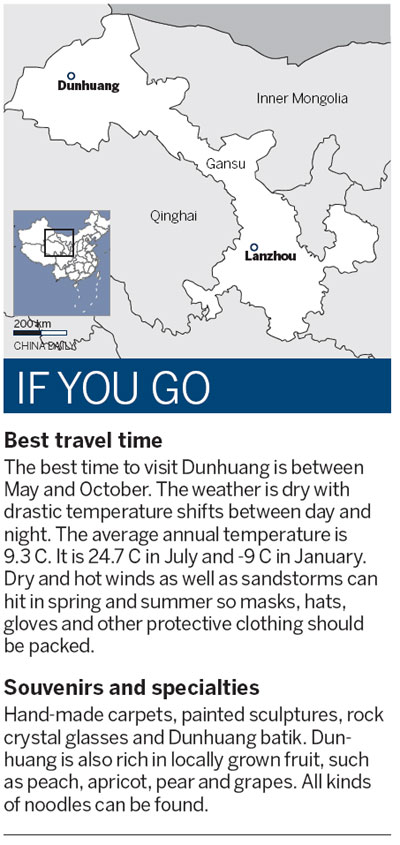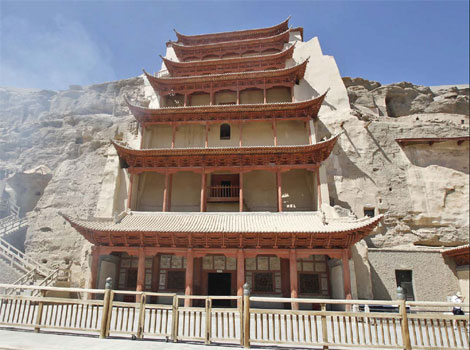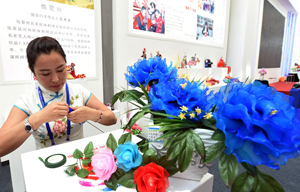Cities
Treasure trove
Updated: 2015-09-17( China Daily )
|
UNESCO put the Mogao Grottoes on the list of World Heritage Sites in 1987. Zhao Hang / For China Daily |
Major oasis town continues to offer link to glories of the past
It has been inextricably linked with the history of China, a name synonymous with the ancient Silk Road that connected the Chinese imperial East with the Roman empire of the West. Many who know little about the precious oases that watered the caravans crossing the treacherous sand dunes will at least have heard about the greatest one of them all, Dunhuang.
Located in Northwest China's Gansu province, Dunhuang has also been a religious and cultural crossing point. The city has continued to develop at an impressive pace in modern times, giving renewed significance to its name, which means to flourish and prosper.
But most visitors still flock to Dunhuang because of its reputation as a treasure trove of historical and cultural artifacts that helped it witness the rise and fall of ancient civilizations.
Here are some of its top attractions.
1. The Mogao Grottoes
The Mogao Grottoes, also known as Thousand Buddha Caves, preserve nearly a thousand years of Buddhist statues. UNESCO put it on the list of World Heritage Sites in 1987. Its 492 grottoes are filled with exquisite Buddhist art and manuscripts, including more than 2,000 colored statues and wall paintings covering 45,000 square meters.
The grottoes were initially built in AD 366. Massive building was carried out in the following Chinese dynasties when Buddhism flourished and Mogao accumulated the artistic essence of the paintings, sculptures and architecture of the times. Wall paintings mostly reflect Buddhist stories and history, while social activities such as agricultural planting, weaving, traveling, dancing, weddings and war also made up the themes of the murals.
Along with the Longmen, Yungang and Maijishan grottoes, Mogao is one of the best known Chinese Buddhist grottoes.
Nearby is the White Horse Pagoda, built by Buddhist monk Kumarajiva, a renowned translator from India, in honor of his horse that died while it brought him to China.
2. Mingsha Shan (Echoing-Sand Mountain) and Yueya Quan (Crescent Spring)
The Mingsha Shan and Yueya Quan are twin spots of natural scenery in the wild Gobi Desert located near Dunhuang. Mingsha is 7 kilometers from downtown Dunhuang and covers about 200 square kilometers. The mountain is made up of mounds of shifting sands that reach 40 km from east to west and 20 km from south to north. Visitors can slide down along the slopes.
Yueya Quan is at the northern foot of Mingsha. The spring is 118 meters from east to west and 25 meters from south to north. The crescent-like lake is surrounded by sand but never seems to drain, with the water clear all year round. Around the spring you can find two kinds of Chinese traditional medicine grown locally - the meddler and apocynum.
3. Yadan National Geological Park
The park features unique landforms created by wind erosion in the Gobi Desert. Yadan in the Uygur language means a steep wall on the hill. The landform took shape about 700,000 years to 300,000 years ago.
Local residents call the area the Yadan Abode of Demons, as the hills in the park are said to make strange sounds when the wind blows.
4. The Yangguan Pass (The Sun Pass)
As part of the Great Wall, Yangguan was an important pass on the southern part of the ancient Silk Road as well as a significant gateway connecting central China with the western regions. The pass was originally built in the Han Dynasty about 107 BC to keep out marauding hordes. Sitting 75 km southwest of Dunhuang, sections of the pass lie buried in the shifting desert sands.




